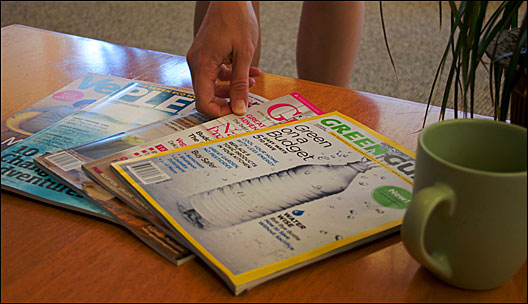
Periodically, I find myself wandering the ever-expanding magazine aisles at local newsstands and bookstores. And I’m often overwhelmed by the sheer volume of, well, volumes. You’ve got mags for every hobby, interest, celeb, fetish, and lifestyle.
So when I set out to grab some light reading about light green, I expected to be inundated with options. I stocked up on Band-Aids just anticipating the paper cuts involved in an exhaustive flip-thru of every green-living rag out there.
But when I actually hit the stands, I found myself poking around, peeking behind every iteration of celeb goss and car porn, and coming up quite short. Web research proved no more fruitful, with dead ends like Verdant, a lifestyle title whose launch seems endlessly delayed, and green-titled magazines that turned out to be about golf and John Deere tractors. I picked the brains of my fellow staffers, but they mainly came up with the more traditional publications put out by environmental orgs (OnEarth, Sierra Magazine, Orion, etc.) — valuable in their own right, but not what I was after. Were there no consumer-oriented green magazines making a go of it?
Grist’s Pick
Plenty
96 pages, $4.95
Frustrated by the lack of options, I thought about shelving the project altogether. But the idea of reading magazines all day (and getting paid for it!) kept me going — as did the value I knew I could impart to you, dear reader.
After scouring several more Seattle locations, I finally came away with five “lifestyle” publications aimed at general audiences. I inspected each one carefully, noting in particular the type of paper used (perhaps the whole “dead-tree” thing is the reason for the poor offering — after all, your best green living source is online, isn’t it?) and the number of annoying subscription cards that fell out as I read — a particular pet peeve of mine and a complete waste of paper.
Here are my results. And if you can suggest any green living magazines I’ve missed, let us know in the comments section below.
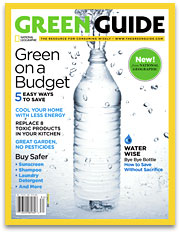
National Geographic’s Green Guide
Summer 2008
96 pages, $4.95
Tagline: The resource for consuming wisely
Frequency: Quarterly
Publisher: National Geographic Society
Annoying subscription cards: 1
Eco-paper? Yes, but just 10 percent recycled content (FSC Mixed Source)
As the familiar yellow border makes clear, this is an offering from the good folks at National Geographic, borne out of its recent acquisition of The Green Guide, an online guide for eco-consumers. It’s mostly tip-based — this issue contains advice on dilemmas like which shampoo to use, what to look out for in your sunscreen, and what kind of beef (grass-fed, hormone-free, etc.) is best — with a few longer features thrown in on topics like what happens to your recycled glass. Overall, it’s helpful, for sure, but not the kind of magazine you cuddle up with for a leisurely read. Bonus points for the tear-out Dirty Dozen Smart Shopper’s Guide (this one on ingredients to avoid in personal-care products).

The Green Parent
April/May 2008
90 pages, $11.49 (import)
Tagline: Raising kids with confidence
Frequency: Bimonthly
Publisher: Green Parent Publications
Annoying subscription cards: 0
Eco-paper? Yes, printed on recycled paper using veggie-based inks. Several notes throughout urge readers to recycle the mag by giving it away to friends.
Billed as “the U.K.’s leading green lifestyles magazine,” The Green Parent is actually printed in England and imported here, a (relatively obvious) fact I didn’t realize until I’d paid its not-so-pretty purchase price — not to mention the associated carbon debt. That aside, I’d definitely recommend this to Brit mums and dads. Though this issue was a “pregnancy and birth special,” it also contained content aimed at families (“The Great Green Adventure”) and those wishing to forget (if only for a short time) about kids entirely, including an interesting feature on green-built cob homes. Bonus points for the eco-sourcebook at the back of the mag, which offers bite-size tips, Q&A quickies, and product info for time-strapped readers.
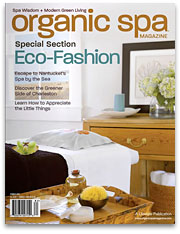
Organic Spa
Summer 2008
80 pages, $4.99
Tagline: Spa wisdom and modern green living
Frequency: Quarterly
Publisher: Oceans Publishing Company, Ltd.
Annoying subscription cards: 2
Eco-paper? Yes, cover is printed on 50 percent recycled content and inside pages are printed on 30 percent post-consumer recycled content, with linseed oil-based ink.
It should be no surprise that a title like Organic Spa would feature soothing earth-tone imagery and peaceful prose on everything from lotions to teas to compostable dishware. But I was surprised how quickly it all put me to sleep. (Which was quite awkward, since I was at work at the time.) The pieces that did manage to catch my attention were the short product-y blurbs about eco-office supplies and eco-fashion (though even those were a bit dated; our green fashion feature last fall featured some of the same images). Perhaps this mag is more for those in touch with their Zen sides. Bonus points for the “Hip Hostess” column featuring recipe gems like the organic cucumber mojito.
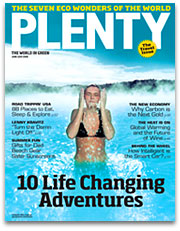
Plenty
June/July 2008
96 pages, $4.95
Tagline: The world in green
Frequency: Bimonthly
Publisher: Environ Press, Inc.
Annoying subscription cards: 0
Eco-paper? Yes. Cover stock uses 10 percent recycled content, while inside pages are 85 to 100 percent recycled content. All is Forest Stewardship Council-certified and made using green power, and the publishers offset their carbon footprint through eMission Solutions.
As its title suggests, Plenty has a lot to offer: a good mix of the politico-wonky (“Why Carbon Is the Next Gold” and “How Intelligent Is the Smart Car?”) and lifestyley, lighter fare (an interview with Lenny Kravitz and vaca-related pieces made up this “travel issue”). I could see the short-and-sweet tip sheets on the best sunscreens or cleaning sprays being quite helpful. But what I like best about this magazine is its overall design: The bright colors, bold headlines, and image-heavy presentation make eco-ness feel exciting, relevant, modern, and fun. Bonus points for showing that green doesn’t have to mean compromises or condescension.
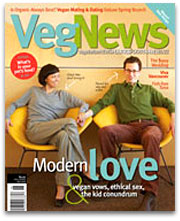
VegNews
June 2008
98 pages, $4.95
Tagline: Vegetarian news, politics, food, travel, buzz
Frequency: Bimonthly
Publisher: The Vegan News Network
Annoying subscription cards: 1
Eco-paper? Yes. Environmental benefits statement lists paper as 75 percent de-inked recycled fiber, processed chlorine free. It also lists the other resources that go into production, including number of trees (134) and amounts of water (77,897 gallons), energy (119 million BTU), solid waste (8,040 lbs.), and greenhouse gases (17,106 lbs.).
This magazine is centered around a veggie diet, natch, but it goes beyond recipes to offer veg-related politics, travel, and other news. If you can get past all the anti-meat language (“carnivore wannabe” and “cadaver sandwich”), you’ll find interesting features — in this case, on the pet food industry, the “baby or no baby” question, and “vegetarian survival phrases” for travel in Laos. A spread on vegan weddings offered personal stories and complete menus for eight nuptials. Bonus points for the back-page feature “what’s in your fridge” — this one featuring vegan cookbook author Terry Hope Romero.
Bottom Line: Plenty gets my vote because of its fresh take on what it means to be eco-aware, plus its plentiful features for all types of interests — and all shades of green.

